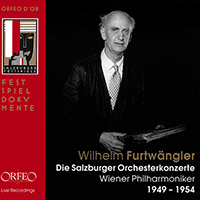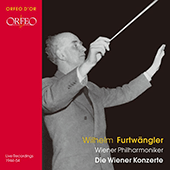Willi Boskovsky
Willi Boskovsky became world famous in 1954 when he succeeded Clemens Krauss as conductor of the Vienna Philharmonic’s New Year’s Day Concerts (broadcast first on radio and later television), although he had been concertmaster of the Vienna Philharmonic Orchestra since 1936. He was also the chief conductor of the Johann Strauss Orchestra of Vienna until his death. Instrumental in reviving the ‘Vorgeiger’ tradition set by Johann Strauss I—conducting an orchestra from the violin—Boskovsky was highly acclaimed for his direction of Strauss’s music, carrying off the well-loved style with ease, lightness and humour.
Boskovsky graduated from the Vienna Academy in 1927. He led his own quartet with Philipp Matheis (second violin), Gunther Breitenbach (viola) and Nikolaus Hübner (cello); players who, with Johann Krump (double-bass), Alfred Boskovsky (clarinet), Josef Veleba (horn) and Rudolf Hanzl (bassoon) formed the Vienna Octet and made several recordings that are still favourites today.
Recording for Decca in the 1950s proved fortuitous: his recordings were among the earliest in stereo and became some of Decca’s best sellers. With the Vienna Mozart Ensemble (assorted members of the VPO) Boskovsky recorded Mozart’s complete dances and marches during the 1960s; many were included on the Philips/Polygram ‘Complete Mozart’ CD set issued in the 1990s. He also recorded for EMI a series of Viennese operettas; in 1972 the New York Times praised his Die Fledermaus for its ‘razor-sharp precision’ and ‘muscular thrust’, remarking that ‘he can kick up his heels when called for and still preserve the undercurrent of warmth.’
Notably, Boskovsky’s 1979 New Year’s Day Concert was recorded live by Decca in the first commercial use of their proprietary PCM digital system. The resulting two-LP set was received by The Gramophone magazine as ‘a riotous issue [ … ] astoundingly vivid and atmospheric’ and has been re-released in the Decca Legends series.
Few violinists could more accurately claim to embody Viennese style and upbringing than Boskovsky, but his playing on record is an acquired taste. For many, his almost perfect tone is the epitomy of Romanticism and richness; for others he reduces the trials and tribulations of compositional greatness to mere chocolate-box fancies. Thus, Beethoven’s Septet, Op. 20 (1950) and Mozart’s Violin Concerto K. 216 (1960) are played with great beauty, but transformed from seminal works to high-class background music by an indefinable quality of tonal perfection. Some recordings, such as Brahms’s Op. 115 Clarinet Quintet (1961), have much greater depth and intensity, whilst two 1950s recordings of Schubert’s ‘Trout’ Quintet made with Walter Panhoffer and Clifford Curzon respectively are suitably entertaining. A live 1950 recording of Brahms’s Double Concerto (with Emanuel Brabec on cello) suffers from Furtwängler’s characteristically turgid tempi and is awash with clumsy phrasing, but allowances should perhaps be made for the fact that Boskovsky and Brabec were pulled out of the VPO as late stand-ins for Menuhin and Casals.
© Naxos Rights International Ltd. — David Milsom (A–Z of String Players, Naxos 8.558081-84)


















